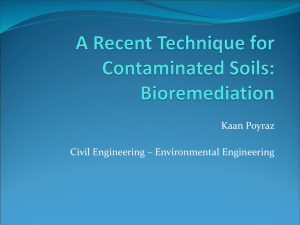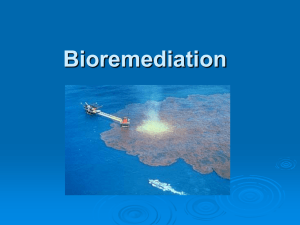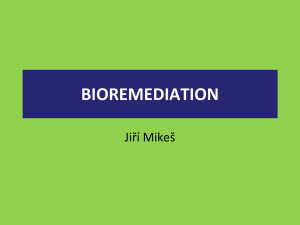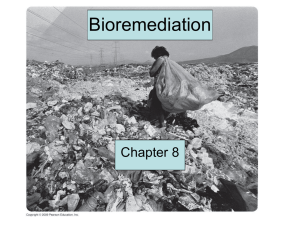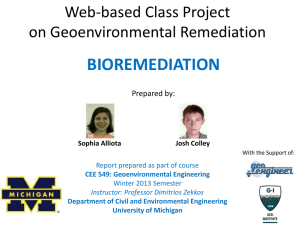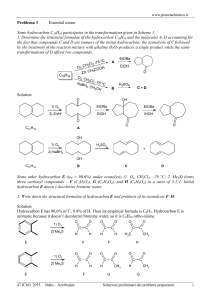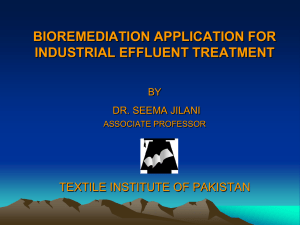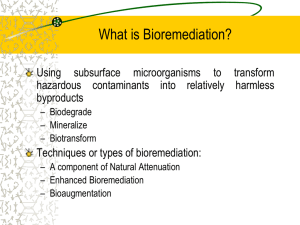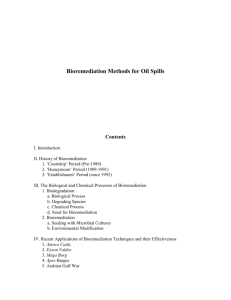Case study 2: degradation of crude oil by halophilic Archaea
advertisement
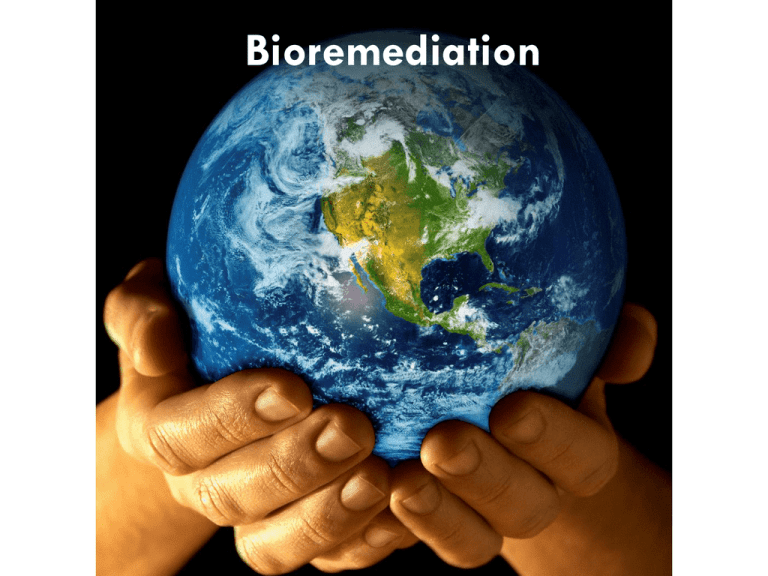
Bioremediation Bioremediation Defined • Any process that uses microorganisms, fungi, green plants or their enzymes to break down harmful chemicals and pollutants in order to return the environment to its original natural condition. • “Bioremediation is not only about genetics and enzymology but also about physiology and ultimately ecology.”—de Lorenzo V: Systems biology approaches to bioremediation. Curr Opin Biotechnol 2008, 19:579-589. Alleviating Pollution • Ex situ or in situ intervention – Natural attenuation • Example: phytoremediation (hyperaccumulators) store heavy metals in vacuoles – Sebertia acuminata 20% dry weight is nickel. – Plants on side of freeways are taking up lead from gas exhaust – Bio-stimulation • Add nutrients (nitrate/sulfate) that cause blooms of naturally occurring microbial bioremediators. – Example: bacteria that metabolize polycyclic aromatic hydrocarbons or polychlorinated biphenyls – Bio-augmentation • Genetically Modified Bioremediators – Alter organisms to manufacture proteins for desired metabolism » Yellow poplar tree given enzyme mercuric reductase thrives in mercury soil, cadmium, TCE » Bacteria gene breaks down TNT is linked to jellyfish gene that glows. Bacteria spread on soil glows green near explosives » Chakrabarty first patented oil eater bacterium. Combined 4 plasmids in one bacterial cell gave it the ability to degrade four components of crude oil. Why do we even need it? • We can’t seem to stop polluting – Inorganics • Uranium, technicium, sulfur, slfuric acid – Explosives • RDX, TNT – Polyaromatic hydrocarbons • creosote – Chlorinated hydrocarbons • Trichlorethylene, PCBs, pentachlorophenol – Petroleum hydrocarbons • • Gas, gas additives (MTBE), deisel From mid-1980’s up to 90’s numerous attempts were made to design GMO for environmental release for pollutants and heavy metals (USGS). – Failures to program: bacteria doesn’t behave in a predictable fashion from the lab. Case Study 1 Case Study 1 cont… • Most failures at bioremediation are due to failure of introduced organisms to thrive in the natural environment or a failure to access the contaminant. This could be due to: – – – – – – • Lack of nutrients Predation or parasitism Competition (GEM’s tend to compete poorly with indigenous populations). Immobility of introduced bacteria Contaminant concentrations below threshold for organism survival Organisms may feed on alternative substrates (E. coli and Pseudomonas diverge genetically from initial inoculum in field trials). A few examples of failed bioremediation attempts: – Inoculation of soil with aliphatic hydrocarbon degrading bacteria did not enhance degradation of fuel oil • Venosa AD, Wrenn BA (1996) Selective enumeration of aromatic and aliphatic hydrocarbon degrading bacteria by a most-probable number procedure. Can. J. Microbiol.42: 252-258 – A Pseudomonas sp. shown in lab cultures to degrade 1,4-dichlorophenol failed to degrade the compound when added to surface soils • Sayler GS, Ripp S (2000) Field applications of genetically engineered microorganisms for bioremediation processes. Curr Opin Biotechnol 11:286-289 Case study 2: degradation of crude oil by halophilic Archaea Defining bioremediation by natural attenuation – what is the environment? what is the pollutant? – are bacterial, Archaeal, and/or plant species present that degrade the pollutant of interest? – what conditions (nutrient, temperature, pH, salt etc) are necessary for that activity? Defining bioremediation by natural attenuation: hydrocarbon degradation in the Arabian Gulf hypersaline coast – what is the environment? what is the pollutant? • the hypersaline coast of the Arabian coast • crude oil (hydrocarbons) West, Ian. 2008. Qatar - sabkhas, evaporites and some other desert features: an introduction. http://www.soton.ac.uk/~imw/Qatar-Sabkhas.htm Defining bioremediation by natural attenuation: hydrocarbon degradation in the Arabian Gulf hypersaline coast – what is the environment? what is the pollutant? • the hypersaline coast of the Arabian coast • crude oil (hydrocarbons) – are bacterial, Archaeal, and/or plant species present that degrade the pollutant of interest? 2 Haloferax strains 1 Halobacterium strain 1 Halococcus strain environmental samples grow on minimal mineral plates with crude oil vapor as sole carbon/energy source (Al-Mailem et al., 2010 Extremophiles) Defining bioremediation by natural attenuation: hydrocarbon degradation in the Arabian Gulf hypersaline coast – are bacterial, Archaeal, and/or plant species present that degrade the pollutant of interest? C18 hydrocarbon autoclaved control Haloferax isolate Halobacterium isolate Halococcus isolate gas-liquid chromatography to measure hydrocarbon degradation (Al-Mailem et al., 2010 Extremophiles) Defining bioremediation by natural attenuation: hydrocarbon degradation in the Arabian Gulf hypersaline coast – what conditions (nutrient, temperature, pH, salt etc) are necessary for that activity? • increased salt increased hydrocarbon degradation Haloferax isolate Haloferax Haloferax isolate isolate Halococcus isolate Halobacterium isolate (Al-Mailem et al., 2010 Extremophiles) How could this hydrocarbon degradation activity by Haloarchaea be improved? • General strategies for improving microbial bioremediation: stimulation or augmentation • Some existing bio-engineering tools – University of Minnesota Biocatalysis/Biodegradation Database (UMBBD): enzymes, pathways, reactions, compounds from hundreds of bacterial species of interest (Gao et al., 2010) – MetaRouter: tracks possible breakdowns from a starting point using all possible reactions (Pazos et al., 2005) – in silico modeling of altered strains: ex. Optstrain (Pharkya et al. 2004), DESHARKY (Rodrigo et al. 2008) How could this hydrocarbon degradation activity by Haloarchaea be improved? • How could systems level knowledge help design stimulation or augmentation strategies? – – – – – – – need to know network topology of the pathway being added or altered as well as the influence of the environment on that pathway understand coupling of pathways to better integrate the engineered or altered pathway into the rest of the host system understand demands created by the new flux on resources needed for growth/survival: energy, carbon, redox balance, transcriptional and translation capacity is it possible to compensate by altering regulation by TFs etc, or by adding or deleting other pathways? understand effect of environment on pathway flux understand role of noise in pathway regulation if cooperation between multiple microbial species is used, then systems analysis can evaluate impact of biodegradative flux on the multispecies consortia
